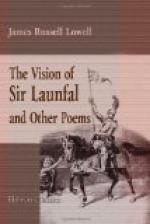Critical judgment upon The Vision of Sir Launfal is generally severe in respect to its structural faults. Mr. Greenslet declares that “through half a century, nine readers out of ten have mistaken Lowell’s meaning,” even the “numerous commentators” have “interpreted the poem as if the young knight actually adventured the quest and returned from it at the end of years, broken and old.” This, however, must be regarded as a rather exaggerated estimate of the lack of unity and consistency in the poem. Stedman says: “I think that The Vision of Sir Launfal owed its success quite as much to a presentation of nature as to its misty legend. It really is a landscape poem, of which the lovely passage, ‘And what is so rare as a day in June?’ and the wintry prelude to Part Second, are the specific features.” And the English critic, J. Churton Collins, thinks that “Sir Launfal, except for the beautiful nature pictures, scarcely rises above the level of an Ingoldsby Legend.”
The popular judgment of the poem (which after all is the important judgment) is fairly stated by Mr. Greenslet: “There is probably no poem in American literature in which a visionary faculty like that [of Lowell] is expressed with such a firm command of poetic background and variety of music as in Sir Launfal ... its structure is far from perfect; yet for all that it has stood the searching test of time: it is beloved now by thousands of young American readers, for whom it has been a first initiation to the beauty of poetic idealism.”
While studying The Vision of Sir Launfal the student should be made familiar with Tennyson’s Sir Galahad and The Holy Grail, and the libretto of Wagner’s Parsifal. Also Henry A. Abbey’s magnificent series of mural paintings in the Boston Public Library, representing the Quest of the Holy Grail, may be utilized in the Copley Prints. If possible the story of Sir Galahad’s search for the Grail in the seventeenth book of Sir Thomas Malory’s Morte Darthur should be read. It would be well also to read Longfellow’s King Robert of Sicily, which to some extent presents a likeness of motive and treatment.
THE COMMEMORATION ODE
In April, 1865, the Civil War was ended and peace was declared. On July 21 Harvard College held a solemn service in commemoration of her ninety-three sons who had been killed in the war. Eight of these fallen young heroes were of Lowell’s own kindred. Personal grief thus added intensity to the deep passion of his utterance upon this great occasion. He was invited to give a poem, and the ode which he presented proved to be the supreme event of the noble service. The scene is thus described by Francis H. Underwood, who was in the audience:




